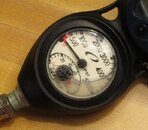a-marshal
Registered
How does this happen?
(sorry if this is the wrong forum)
After an annual service the first time we hooked the gauge to a tank it slowly started to fill with murky fluid (water?), eventually looking like the attached image. When submerged there were no bubbles from the gauge or hose. We swapped out the gauge and after a few days the fluid was gone leaving a film on the crystal and a non-functioning thermometer. The tank it was hooked to was a tank from a busy resort op., it breathed well and we couldn't detect any moisture in the gas.
I can't think of any way this could NOT have been the fault of the service.. but before I get all cranky at the shop is there any other way this could have happened?
Thanks

(sorry if this is the wrong forum)
After an annual service the first time we hooked the gauge to a tank it slowly started to fill with murky fluid (water?), eventually looking like the attached image. When submerged there were no bubbles from the gauge or hose. We swapped out the gauge and after a few days the fluid was gone leaving a film on the crystal and a non-functioning thermometer. The tank it was hooked to was a tank from a busy resort op., it breathed well and we couldn't detect any moisture in the gas.
I can't think of any way this could NOT have been the fault of the service.. but before I get all cranky at the shop is there any other way this could have happened?
Thanks





